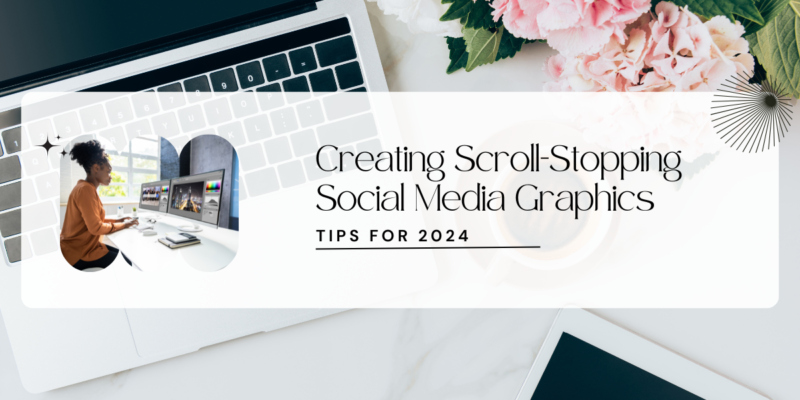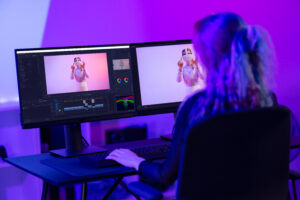
The social media age makes it incredibly difficult to be visible. However, the ability to create content that makes the audience stop scrolling through their feeds has become an interesting challenge. However, don’t panic! Whether you are an advanced or inexperienced graphic design expert, there are tried and true methods that will enable you to create click-bait, scroll-stopping, social media visuals. Looking ahead into 2024, it is easier to predict that advancement in tools, trends, and strategies will grow towards capturing the attention of the audience.
In this article, we will give both practical and technical recommendations on how to make your social media graphics even more interesting, including making design changes according to the network, and employing tools with artificial intelligence. Let’s do this!
Understanding Platform-Specific Design Requirements
Social media is not a one size fits all kind of a situation, all these social media networks have their particular design consideration. One of the approaches in developing any social media graphics that works is having the graphics according to the specific social media platform that you’re focusing on.
Instagram, TikTok, and Facebook: The Differences
- Instagram: Best known among the social networks for its visual orientation, the users of Instagram require the content to be uploaded in high resolution. Instagram has to be installed in such a way that the graphics are so engaging that there is no chance of the viewer relaxing the mobile device. Two best orientations on offer are square (1080×1080) and portrait (1080×1350) which help in utilizing maximum screen.
- TikTok: It is obvious that TikTok is a video platform since everything revolves around video content, however do not forget about the thin layer of thumbnails or static postings. The vertical structure (9:16 ratio) of the screen guarantees that user’s own content will occupy entire display area, making content even more interactive for the audience.
- Facebook: While Facebook accommodates multiple formats, posts with horizontal images or short videos tend to perform well. Also, take advantage of Facebook’s ad tools to adjust content for both desktop and mobile users.
Platform Optimization Tips
- Post bright and large pictures on Instagram and TikTok so they can break through the news feeds of the users.
- Make sure all text is centered with no lengthy strips of contents especially on the mobile view of the blog.
- Check the quality of your designs on varying outputs to determine whether or not it poses a design problem.
The Power of Simplicity: Less is More
With the overwhelming amount of information available in the modern world of technology, going back to the fundamentals may be more beneficial than going over the top. Crowded typeface leads to overwhelmed users resulting to scrolling away from your design or post. A minimalist approach is advisable as it spots the message to be delivered without any delay.
Why Simplicity Works
- Easy to Digest: Social media is typically an action-based environment and users pay attention to posts and quickest loots. Simple images with a central concept are simpler for the mind.
- Better for Mobile: It has been accepted that simple designs look perfect on the small screens. Avoid overwhelming users with too much information at once.
How to Keep it Simple
- Have one clear identifiable prompt which forms the key visual element.
- Make use of precis writing and keep the text brief and clear. A statement like this can be best explained with a headline in mind.
- White space is your friend! Let your design breathe by giving elements room around them.
Example: A minimalist post, which contains only a product’s image and product CTA, can lead to a better outcome as compared to a moderately cluttered style that relies on a collage of product images.
Leveraging Bold Typography for Impact
When creating graphics for social networks, typography is probably the most determining aspect of your design. Strong typeface provides the primary message quickly as even a reader’s ability decreases in a scrolling motion rhythm.
Typography Tips
- Use the large fonts for the title so as to catch the attention straight away.
- Use bold letters with contrasting background for easy reading. For example, white text on a dark background or vice versa.
- Avoid using many different fonts at a time. Do not use more than two or three font styles to prevent clutter.
Make Text Part of the Design
Typography can also serve as a graphic unit and can be a cute element of the design. Play around with font sizes, letter spacing, and alignments so that they themselves are pretty without the usage of pictures.
Color Psychology: Choosing the Right Colors for Your Audience
There’s no precipice for success of bad concept behind the graphic design of social media as colour has its place in there as well. They stimulate feeling and set the mood in your content as well. If you understand what colors evoke what feelings, you will be able to design your posts more adequately to the target audience.
Colors and Emotions
- Red: Excitement, urgency (great for sales posts).
- Blue: Trust, calmness (often used by brands in finance or healthcare).
- Yellow: Happiness, energy (perfect for upbeat, friendly brands).
- Green: Growth, balance (often used in eco-friendly or wellness industries).
Consistent Color Schemes
Provide a visual identity for your brand by using the same colors across the posts. This makes it easier for the viewers to spot your posts on social media. Tools like Coolors or Adobe Color can help you choose colors that would go along quite well.
Integrating Animation and Motion Graphics

As of 2024, the use of static images is no longer sufficient to attract attention. In order to enhance content, it is best to incorporate motion graphics and effects – these will certainly make your content more appealing.
Why Motion Works
- It is common to rearrange shapes so that they can be easily viewed. A moving image would be enough reason to keep the reader still or make them stop scrolling for just a moment.
- Editorial and rotating gif images promise to keep the users for a longer time than an ordinary poster.
How to Use Motion Graphics
- Do not drag animations, keep them simple. Very good animations are good but may tend to lengthen the page load times and be a little overwhelming for the viewers.
- Use platforms like Canva or Adobe After Effects to add motion to your graphics without needing advanced video editing skills.
Using AI-Powered Design Tools for Quick, High-Quality Graphics
Visual designers will appreciate the use of AI tools for doing graphics works as they make work easy and time saving as well as enhancing graphics.
AI-Powered Tools
- Canva: With the help of Ai tools like Magic Resize and AI Background Remover in Canva, One can transform his/her designs from one platform to another or just make edits in an image in a matter of seconds.
- Adobe Photoshop: Most of the things done in a photo shoot can in fact, including retouching, most of the adding effects and great features can and have been done using Neurel Filters, and hence saving the designer many beach dances.
- AutoDraw: Google has created this wonderful app that uses artificial intelligence to convert any sketch you would have made into a polished graphic. This is a useful application for fast ideas or drawing concept designs.
Benefits of AI Tools for Social Media Graphics
- Speed: AI tools assess designs more quickly allowing you to make more posts within a shorter period without compromising the quality.
- Automation: Tasks like resizing, background removal, or even generating color palettes can be automated, making it possible for you to undertake other more creative aspects.
Effective Use of Visual Hierarchy
Visual hierarchies help manage the arrangement of the design elements in a manner that directs attention to the order of exposure through the composition. It is very important in social media graphics, where people are overwhelmed with information, and it is necessary to tell them which part they have to see first!
How to Establish Visual Hierarchy
- Size and Scale: Always consider making important elements bigger like a product or a main message, and make supporting ones smaller.
- Color and Contrast: Use such beautiful colors that don’t simply “paint” but serve to accentuate the areas of importance in the layout.
- Spacing and Alignment: Include ample white space around your content to avoid cluttering.
Example: The main object in the promotional graphics should be the product (usually the biggest element) then the headline (discount or CTA) and at the bottom small text.
Conclusion
Creating scroll-stopping social media graphics is about more than just pretty pictures. It’s about understanding your audience, using platform-specific strategies, and leveraging the latest design trends. The scope of engaging content creation for the year 2024 is wide-ranging from strong fonts used in minimalism to the integration of AI systems and the use of real photos.
As much as one continues to use social media, their design also has to change. Get the best and current trends. You may want to play with techniques instead of staying put and do remember your audience. With these tips in hand, you’ll be well on your way to creating graphics that stop the scroll and captivate your audience.










